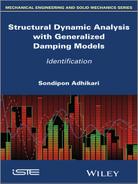Book Description
Since Lord Rayleigh introduced the idea of viscous damping in his classic work "The Theory of Sound" in 1877, it has become standard practice to use this approach in dynamics, covering a wide range of applications from aerospace to civil engineering. However, in the majority of practical cases this approach is adopted more for mathematical convenience than for modeling the physics of vibration damping.
Over the past decade, extensive research has been undertaken on more general "non-viscous" damping models and vibration of non-viscously damped systems. This book, along with a related book Structural Dynamic Analysis with Generalized Damping Models: Analysis, is the first comprehensive study to cover vibration problems with general non-viscous damping. The author draws on his considerable research experience to produce a text covering: parametric senistivity of damped systems; identification of viscous damping; identification of non-viscous damping; and some tools for the quanitification of damping. The book is written from a vibration theory standpoint, with numerous worked examples which are relevant across a wide range of mechanical, aerospace and structural engineering applications.
